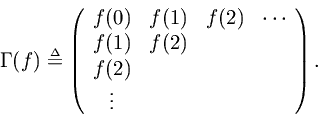NOTE: THIS DOCUMENT IS OBSOLETE, PLEASE CHECK THE NEW VERSION: "Introduction to Digital Filters with Audio Applications", by Julius O. Smith III, Copyright © 2017-11-26 by Julius O. Smith III - Center for Computer Research in Music and Acoustics (CCRMA), Stanford University
<< Previous page TOC INDEX Next page >>
Specific Norms
The
norms are defined on the space
by
norms are technically pseudo-norms; if functions in
are replaced by equivalence classes containing all functions equal almost everywhere, then a norm is obtained.
Since all practical desired frequency responses arising in digital filter design problems are bounded on the unit circle, it follows that
forms a Banach space under any
norm.
The weighted
norms are defined by
whereis real, positive, and integrable. Typically,
. If
for a set of nonzero measure, then a pseudo-norm results.
The case
gives the popular root mean square norm, and
can be interpreted as the total energy of
in many physical contexts.
An advantage of working in
is that the norm is provided by an inner product,
The norm of a vectoris then given by
As
approaches infinity in Eq. (3.1), the error measure is dominated by the largest values of
. Accordingly, it is customary to define
and this is often called the Chebyshev oruniform norm.Suppose the
norm of
is finite, and let
denote the Fourier coefficients of. When
is afilter frequency response,
is the corresponding impulseresponse. The filter
is said to be causal if
for
.
The norms for impulse response sequences
are defined in a manner exactly analogous with the frequency response norms
, viz.,
These time-domain norms are callednorms.
The
and
norms are strictly concave functionals for
(see below).
By Parseval's theorem, we have
, i.e., the
and
norms are the same for
.
The Frobenious norm of an
matrix
is defined as
That is, the Frobenious norm is thenorm applied to the elements of the matrix. For this norm there exists the following.
Theorem. The unique
rank
matrix
which minimizes
is given by
, where
is a singular value decomposition of
, and
is formed from
by setting to zero all but the
largest singular values.
Proof. See Golub and Kahan [Golub and Van Loan 1989].
The induced norm of a matrix
is defined in terms of the norm defined for the vectors
on which it operates,
For thenorm, we have
and this is called the spectral norm of the matrix.
The Hankel matrix corresponding to a time series
is defined by
, i.e.,
Note that the Hankel matrix involves only causal components of the time series.The Hankel norm of a filter frequency response is defined as the spectral norm of the Hankel matrix of its impulse response,
The Hankel norm is truly a norm only if, i.e., if it is causal. For noncausal filters, it is a pseudo-norm.
If
is strictly stable, then
is finite for all
, and all norms defined thus far are finite. Also, the Hankel matrix
is a bounded linear operator in this case.
The Hankel norm is bounded below by the
norm, and bounded above by the
norm [Genin 1981],
with equality iffis an allpass filter (i.e.,
constant).








